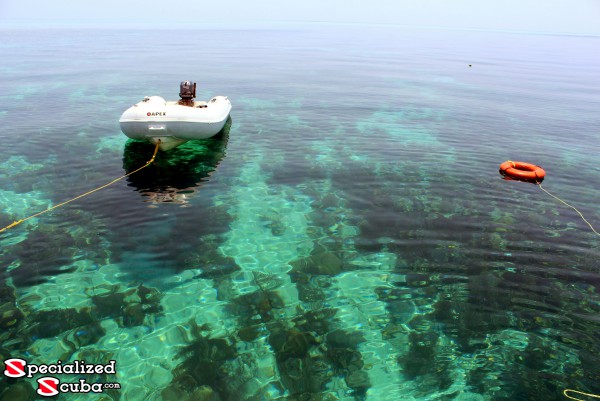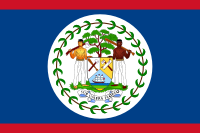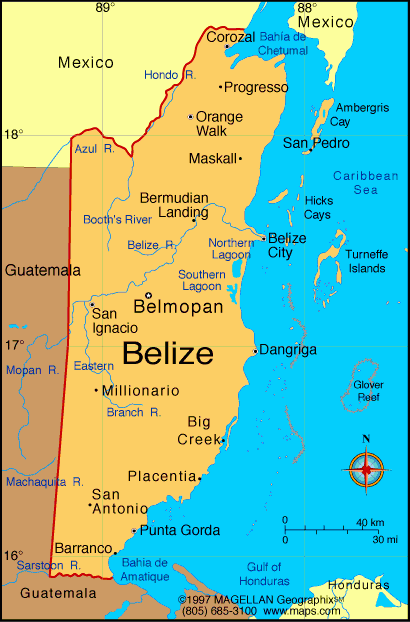SailDives - Belize
from Placencia - Boarding Saturdays at 5 PM. Shows chronological listing of all SailDives cabins available in Belize. Click "Reserve a Cabin" to see the list.
 | Overview Yachts Itinerary |
Overview
Location
Belize (beh-LEES) is an English speaking country located on the Caribbean coast of northern Central America. It shares a border on the north with the Mexican state of Quintana Roo, on the west with the Guatemalan department of Petn, and on the south with the Guatemalan department of Izabal. To the east in the Caribbean Sea, the second-longest barrier reef in the world flanks much of the 386 kilometres (240 mi) of predominantly marshy coastline.
 The area of the country totals 22,960 square kilometres (8,865 sq mi), an area slightly larger than El Salvador or Massachusetts. The abundance of lagoons along the coasts and in the northern interior reduces the actual land area to 21,400 square kilometres (8,263 sq mi).
The area of the country totals 22,960 square kilometres (8,865 sq mi), an area slightly larger than El Salvador or Massachusetts. The abundance of lagoons along the coasts and in the northern interior reduces the actual land area to 21,400 square kilometres (8,263 sq mi).
Geography
Belize is shaped like a rectangle that extends about 280 kilometres (174 mi) north-south and about 100 kilometres (62 mi) east-west, with a total land boundary length of 516 kilometres (321 mi). The undulating courses of two rivers, the Hondo and the Sarstoon, define much of the course of the country's northern and southern boundaries. The western border follows no natural features and runs north-south through lowland forest and highland plateau. The north of Belize consists mostly of flat, swampy coastal plains, in places heavily forested. The flora is highly diverse considering the small geographical area. The south contains the low mountain range of the Maya Mountains. The highest point in Belize is Doyle's Delight at 1,124 m (3,688 ft).
 The Caribbean coast is lined with a coral reef and some 450 islets and islands known locally as cayes (pronounced "keys"). They total about 690 square kilometres (266 sq mi), and form the approximately 320-kilometre (199 mi) long Belize Barrier Reef, the longest in the Western Hemisphere and the second longest in the world after Australia's Great Barrier Reef. It is the largest reef complex in the Atlantic-Caribbean area. Three of merely four coral atolls in the Western Hemisphere are located off the coast of Belize.
The Caribbean coast is lined with a coral reef and some 450 islets and islands known locally as cayes (pronounced "keys"). They total about 690 square kilometres (266 sq mi), and form the approximately 320-kilometre (199 mi) long Belize Barrier Reef, the longest in the Western Hemisphere and the second longest in the world after Australia's Great Barrier Reef. It is the largest reef complex in the Atlantic-Caribbean area. Three of merely four coral atolls in the Western Hemisphere are located off the coast of Belize.
Species
The Belize Barrier Reef is home to a large diversity of plants and animals, one of the most diverse ecosystems of the world:
70 hard coral species
36 soft coral species
500 species of fish
hundreds of invertebrate species
With 90% of the reef still needing to be researched, it is estimated that only 10% of all species have been discovered.
Activities
Biking, Bird Watching, Camping, Canoeing, Caving, Ecotours, Fly Fishing, Sport Fishing, Glass bottom boat trips, Hiking, Horseback riding, Manatee Watching, Mayan Ruins, Para-sailing and Sailing, Scuba Diving, Snorkeling, River and Sea Kayaking, Rafting and Tubing, Rock Climbing and Windsurfing.
Climate
Belize has a tropical climate with pronounced wet and dry seasons, although there are significant variations in weather patterns by region. Temperatures vary according to elevation, proximity to the coast, and the moderating effects of the northeast trade winds off the Caribbean. Average temperatures in the coastal regions range from 75F (24C) in January to 81F (27C) in July. Temperatures are slightly higher inland, except for the southern highland plateaus, such as the Mountain Pine Ridge, where it is noticeably cooler year round. Overall, the seasons are marked more by differences in humidity and rainfall than in temperature.
Average rainfall varies considerably, ranging from 54 inches (1,350 millimeters) in the north and west to over 177 inches
(4,500 millimeters) in the extreme south. Between January and May, less than 4 inches (100 millimeters) of rain fall per month. The dry season is shorter in the south, normally only lasting from February to April. There is a shorter, less rainy period, known locally as the "little dry," which occurs in late July or August, after the initial onset of the rainy season.
Diving and Snorkeling
 The Belize Barrier Reef lies off the Caribbean coast of Belize, extending 235 km between the Mexican and
Guatemalan borders and between 0.5 to 80 km from the mainland. Diving and snorkeling in Belize are incredibly satisfying along the entire coastline. The Barrier Reef protrudes through the surface of the sea, offering both snorkelers and divers close proximity to this colorful world. There are numerous dive sites along the length and breadth of this barrier reef. All three types of biotic reefs are found in Belizean waters: fringing reefs, barrier reefs and atolls.
The barrier reef, cayes, three major coral ringed atolls and hundreds of patch coral reefs make up a magnificent underwater world full of colorful life waiting to be explored. This pristine marine environment are magnets for aquatic life and play host to a huge variety of species
The Belize Barrier Reef lies off the Caribbean coast of Belize, extending 235 km between the Mexican and
Guatemalan borders and between 0.5 to 80 km from the mainland. Diving and snorkeling in Belize are incredibly satisfying along the entire coastline. The Barrier Reef protrudes through the surface of the sea, offering both snorkelers and divers close proximity to this colorful world. There are numerous dive sites along the length and breadth of this barrier reef. All three types of biotic reefs are found in Belizean waters: fringing reefs, barrier reefs and atolls.
The barrier reef, cayes, three major coral ringed atolls and hundreds of patch coral reefs make up a magnificent underwater world full of colorful life waiting to be explored. This pristine marine environment are magnets for aquatic life and play host to a huge variety of species
Economy and Tourism
A combination of natural factorsclimate, the Belize Barrier Reef (longest in the Western Hemisphere), 127 offshore Cayes (islands), excellent fishing, safe waters (for boating, scuba diving, and snorkeling), numerous rivers (for rafting, tubing and kayaking), jungle and wildlife reserves (for hiking, bird watching, and helicopter touring), as well as many Maya ruinssupport the thriving tourism and ecotourism industry. Development costs are high, but the Government of Belize has designated tourism as its second development priority after agriculture. Above water the scenery is dominated by blue sky, azure seas, palm-studded beaches and exotic bird and other wildlife. Snorkelers, scuba divers, sailors, sport fishermen, bird-watchers and marine biologists return regularly to Belize.
 The economy is based on agriculture, agro-based industry, and merchandising, with tourism and construction recently assuming greater importance. The country is a producer of industrial minerals. Sugar, the chief crop, accounts for nearly half of exports, while the banana industry is the country's largest employer. Trade is important and the major trading partners are the United States, Mexico, the European Union, and Central America. Tourism is an important part of the economy of Belize. The Belizean Dollar BZ$ is the local currency.
Belizeans place great value on their spectacular national treasure, enacting regulation to protect and manage several of their marine reserves and UNESCO World Heritage sites.
The economy is based on agriculture, agro-based industry, and merchandising, with tourism and construction recently assuming greater importance. The country is a producer of industrial minerals. Sugar, the chief crop, accounts for nearly half of exports, while the banana industry is the country's largest employer. Trade is important and the major trading partners are the United States, Mexico, the European Union, and Central America. Tourism is an important part of the economy of Belize. The Belizean Dollar BZ$ is the local currency.
Belizeans place great value on their spectacular national treasure, enacting regulation to protect and manage several of their marine reserves and UNESCO World Heritage sites.
Vegetation
While over 60% of Belize's land surface is covered by forest, some of the country's land is covered by cultivated land (agriculture) and human settlements. Savannah, scrubland and wetland constitute the remainder of Belize's land cover. Important mangrove ecosystems are also represented across Belize's landscape. As a part of the globally significant Mesoamerican Biological Corridor which stretches from southern Mexico to Panama, Belize's biodiversity - both marine and terrestrial - is rich, with abundant flora and fauna. Belize is also a leader where it comes to protecting its biodiversity and natural resources. The Association of Protected Areas Management Organizations of Belize (APAMO) indicates that 36% of Belize's land territory falls under some form of official protected status, giving Belize one of the most extensive systems of terrestrial protected areas in the Americas. Belize's territorial waters - home to the Belize Barrier Reef System - are also protected. The Belize Barrier Reef System both constitutes a UNESCO-recognized World Heritage Site and the second largest barrier reef in the world, second only to Australia's Great Barrier Reef.
As a part of the globally significant Mesoamerican Biological Corridor which stretches from southern Mexico to Panama, Belize's biodiversity - both marine and terrestrial - is rich, with abundant flora and fauna. Belize is also a leader where it comes to protecting its biodiversity and natural resources. The Association of Protected Areas Management Organizations of Belize (APAMO) indicates that 36% of Belize's land territory falls under some form of official protected status, giving Belize one of the most extensive systems of terrestrial protected areas in the Americas. Belize's territorial waters - home to the Belize Barrier Reef System - are also protected. The Belize Barrier Reef System both constitutes a UNESCO-recognized World Heritage Site and the second largest barrier reef in the world, second only to Australia's Great Barrier Reef.




